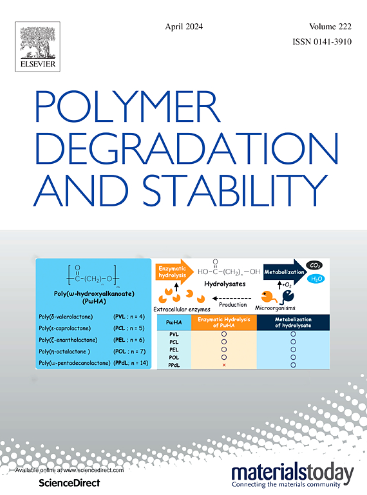Development of stabilizer formulations for Poly(4-methyl-1-pentene) via high-throughput chemiluminescence imaging and genetic algorithm
IF 6.3
2区 化学
Q1 POLYMER SCIENCE
引用次数: 0
Abstract
A combination of high-throughput chemiluminescence imaging and a genetic algorithm was implemented to develop stabilizer formulations for preventing the thermo-oxidative degradation of poly(4-methyl-1-pentene) (PMP). The identified best-performing formulation significantly enhanced the stability of PMP, extending its lifetime at 160 °C. Additionally, the results were compared to those previously obtained for polypropylene (PP) to identify commonalities and differences in stabilizer formulations between these polymers. It was found that both PMP and PP require synergistic combinations of stabilizers, though PMP tends to favor higher proportion of secondary antioxidants. This difference is likely attributed to processing temperatures and diffusion efficiency of molecules in the matrix polymers. Findings from a total of 160 samples (PMP: 90, PP: 70) highlight the importance of iterative optimization of stabilizer formulations.
利用高通量化学发光成像和遗传算法研究聚(4-甲基-1-戊烯)稳定剂配方
采用高通量化学发光成像和遗传算法相结合的方法开发了稳定剂配方,以防止聚(4-甲基-1-戊烯)(PMP)的热氧化降解。确定的最佳配方显著提高了PMP的稳定性,延长了其在160°C下的使用寿命。此外,将结果与先前获得的聚丙烯(PP)的结果进行了比较,以确定这些聚合物之间稳定剂配方的共性和差异。发现PMP和PP都需要稳定剂的协同组合,但PMP倾向于更高比例的次级抗氧化剂。这种差异可能归因于加工温度和分子在基质聚合物中的扩散效率。来自160个样品(PMP: 90, PP: 70)的研究结果强调了稳定剂配方迭代优化的重要性。
本文章由计算机程序翻译,如有差异,请以英文原文为准。
求助全文
约1分钟内获得全文
求助全文
来源期刊

Polymer Degradation and Stability
化学-高分子科学
CiteScore
10.10
自引率
10.20%
发文量
325
审稿时长
23 days
期刊介绍:
Polymer Degradation and Stability deals with the degradation reactions and their control which are a major preoccupation of practitioners of the many and diverse aspects of modern polymer technology.
Deteriorative reactions occur during processing, when polymers are subjected to heat, oxygen and mechanical stress, and during the useful life of the materials when oxygen and sunlight are the most important degradative agencies. In more specialised applications, degradation may be induced by high energy radiation, ozone, atmospheric pollutants, mechanical stress, biological action, hydrolysis and many other influences. The mechanisms of these reactions and stabilisation processes must be understood if the technology and application of polymers are to continue to advance. The reporting of investigations of this kind is therefore a major function of this journal.
However there are also new developments in polymer technology in which degradation processes find positive applications. For example, photodegradable plastics are now available, the recycling of polymeric products will become increasingly important, degradation and combustion studies are involved in the definition of the fire hazards which are associated with polymeric materials and the microelectronics industry is vitally dependent upon polymer degradation in the manufacture of its circuitry. Polymer properties may also be improved by processes like curing and grafting, the chemistry of which can be closely related to that which causes physical deterioration in other circumstances.
 求助内容:
求助内容: 应助结果提醒方式:
应助结果提醒方式:


